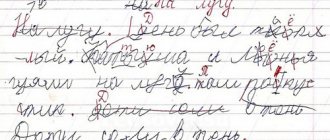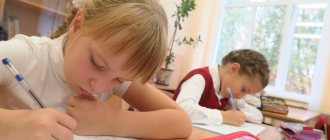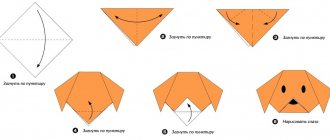Speech therapy examination of the speech of junior schoolchildren
General anamnesis (to be completed by parents)
Child's full name_________________________________________________________________
Date of Birth______________________________Address_________________________________
Information about parents (full name, place of work, position, telephone)
Mother______________________________________________________________________________________________________________________________________________________
Father_________________________________________________________________________
_____________________________________________________________________________
1. From what pregnancy was the child born?______2. What are the birth dates?_____
3. Course of pregnancy (early toxicosis, late toxicosis, injuries, chronic or infectious diseases, hypo- or hypertension, threat of miscarriage, without pathologies, etc.)__________________________________________________________________________
4. How did the birth proceed (early, urgent, rapid, etc.)____________________
5. Apgar scores__________________6. When did you scream?______________________________
7. Was there asphyxia? (white, blue) _______8. Child's height and weight at birth_________
9. Feeding (breastfeeding, artificial, mixed)______________________________
10. When did the first teeth appear?_________11. Number of teeth per year_____________________
12. Past illnesses (infections, bruises, head injuries, convulsions at high temperatures). Up to a year:__________________________________________________________
_____________________________________________________________________________
After a year:__________________________________________________________________________
Vision______________________________Hearing_____________________________________________
Speech anamnesis
When did humming appear?_______________________babble?__________________________
When did the first words appear?_______________phrases?__________________________
Was speech development interrupted? (if interrupted, indicate age, reason, duration, consequences)_________________________________________________
Conditions for speech education in the family
Parents' speech________________________________________________________________
Is there bilingualism in the family?______________________________________________________________
The child’s attitude towards a speech defect__________________________________________________________
Have you contacted a speech therapist? _____________________________________________________
How long did the classes last, their effectiveness __________________________________________
Thank you for your help! Speech therapist teacher, 1st qualification category Aliya Finatovna Khamitova, phone: 89374849655, email: a l _ i _ ya [email protected] mail . ru
General characteristics of speech (recording of a conversation with a child
)
What is your name? How old are you?_______________
Who do you live with?______________________________________________________________
What is your mother's name?_______________________________________________________________
Do you have friends?__________________________________________________________
_____________________________________________________________________________
What games do you play with them?________________________________________________
_____________________________________________________________________________
General sound of speech
Rate of speech (fast, slow, moderate)______________________________________
Voice (quiet, loud)____________Expressiveness___________________________
Manifestation of stuttering___________________________________________________________
Supposed reason______________________________________________________________
Periods of exacerbation__________________________________________________________________________ Situations aggravating its manifestation___________________________________________
The structure of the articulatory apparatus
Lips (thick, thin, cleft)_______________________________________
Tongue (thick, massive, small, etc.)_______________________________________
Teeth (sparse, small, outside the jaw arch, large)________________________________
Bite (prognathia, progenia, open, lateral open)______________________________
Hyoid ligament (short, extended, shortened)__________________________
Articulatory motor skills
Grin____________Raising eyebrows______“Little tube smile”____________
“Swing”______________“Clock”_______________Click your tongue_______________
Mobility, accuracy, range of motion_______________________________________________
Ability to switch and maintain posture__________________________________________
Tremor of the tip of the tongue during repeated movements__________________________________________
Hyperkinesis at a slow pace of movement_____________________________________________
Fine motor skills
Which hand he eats with: right / left writes: right / left
Speech Comprehension Test
1. Follow instructions in 2-3 steps__________________________________________
2. Understanding the names of actions (from pictures)__________________________________________
3. Understanding the names of features (color, shape, size, etc.)______________________
_____________________________________________________________________________
4. Understanding the grammatical forms of words:
a) singular and plural: nouns (ball-balls, mushroom-mushrooms)_____
_____________________________________________________________________________
verbs (where sits, and where sits)__________________________________________________
adjectives (where is red, and where are red)_______________________________________
b) understanding the meaning of prepositions ________________________________________________
c) understanding the meanings of case endings (Show your notebook with a pencil)____________
5. Understanding the meanings of complex sentences:
a) Show the girl who catches a butterfly_____________________________________________
b) Lena lost the pencil that Vova had. Whose pencil is this?_________________
c) The children went into the forest after it rained. When did the children go to the forest: before or after the rain?_______________________________________________________________________
Vocabulary survey
1. Subject dictionary:
a) explanation of the meanings of words:
fridge__________________________________________________________________
vacuum cleaner______________________________________________________________________
b) naming objects from pictures__________________________________________________________
c) display and name of parts of objects:
kettle: bottom___________________________ chair: seat____________________
cover____________________ back____________________
handle______________________ legs__________________________
spout_____________________
d) baby animals:
in a goat___________________________ in a cow___________________________
in a pig__________________________ in a horse___________________________
in a sheep___________________________ in a chicken___________________________
2. Level of generalization:
Teddy bear, ball, pyramid, spinning top__________________________________________________________
Dress, trousers, skirt, socks____________________________________________________________
Boots, shoes, felt boots, slippers_________________________________________________
Wardrobe, bed, sofa__________________________________________________________________________
Bus, plane, train, motorcycle_______________________________________________
3. Dictionary of signs:
a) selection of adjectives for nouns:
lemon (what kind?)________________________________________________________________
fox (what?)________________________________________________________________________________
apple (what kind?)________________________________________________________________
b) selection of antonyms: synonyms:
large — ________________ doctor — ________________________________
tall -_________________ friend — ___________________________
dry - __________________ sad - ___________________
dirty — _________________ schoolboy — ___________________
c) formation of relative adjectives:
cube made of wood - ______________________glass glass -_________________________
rubber ball - _______________________ leather bag - __________________________
d) formation of possessive adjectives:
Whose tail?__________________________________________________________________________
4. Verb dictionary:
a) naming actions based on pictures_______________________________________________
b) Who does what?
Cook__________________________________________driver________________________________
Doctor__________________________________________janitor______________________________
c) Who moves how?
Fish_________________________________bird___________________________
hare_________________________________ dog_________________________________
d) who gives what voice?
Cat____________________ ______________ horse______________________________
Goat_______________________________________donkey________________________________
Dog__________________________________________ rooster ________________________________
5. Seasons and their signs_________________________________________________________
_____________________________________________________________________________
Examination of grammatical structure
1. Education plural. nouns from singular nouns:
Doll____________________chair______________________bucket____________________
Ear______________________ tree__________________
2. Formation of a diminutive form:
House_______________________ball__________________chair_________________________
Ball_______________________bucket__________________nose____________________
3. Agreement of adjectives with nouns:
Ball_________________ _____(red) car______________________(red)
dress_________________________________bucket_________________________________
4. The use of the case of nouns depending on the numerals:
I have one house, and you have _____________________________________________ (two houses)
1 ball ___________________________________1 chair________________________________
1 tomato________________________________1 ear________________________________
Examination of coherent speech
1. Making a proposal based on the picture________________________________________________
_____________________________________________________________________________
2. Compiling a descriptive story based on a plot picture_______________________
_________________________________________________________________________________________________________________________________________________________________________________________________________________________________________________________________________________________________________________________________________________________________________________________________
3. Compiling a descriptive story based on a sequential series of paintings
_________________________________________________________________________________________________________________________________________________________________________________________________________________________________________________________________________________________________________________________________________________________________________________________________
4. Retelling the story (fairy tale)__________________________________________________________
_________________________________________________________________________________________________________________________________________________________________________________________________________________________________________________________________________________________________________________________________________________________________________________________________
Sound pronunciation
Vowels
A___________U_________O__________I____________E_____________Y______________
Consonants
[S] - ___________[S'] - ____________[Z] - __________[Z'] - ___________[C]_____________
[W] - ______________[F] - _____________[H] - _______________[SH] - ________________
[L] - ______________ [L'] - _____________[R] - _______________[R'] - _________________
[K,K'] - ____________[G,G'] - ____________[B,B'] - _____________[P,P'] - _______________ [D,D'] - ____________[T,T'] - ____________[B ,V'] - _____________[F,F'] - ______________
[M,M'] - ___________[N,N'] - ____________[X,X'] - _____________[Y] - ________________
Phonemic Awareness Test
and elements of sound analysis
1. Repetition of sound series:
pa-ba-pa________________________ma-na-ma_________________________________
vo-fo-fo___________________________be-be-ne_________________________________
tu-doo-tu______________________________sa-sa-za___________________________________
2. Repetition of rows of words:
elephant-catfish-dream__________________________teeth-soups-fur coats__________________________
house-tom-tooth__________________________beetle-jester-tooth______________________________
3. Isolating the first sound in a word:
Alik_______duck_______Ira______donkey_________echo________tank_______bow_______
4. Highlighting the last sound in a word:
Poppy_fluff________soup________sweat_______flour_______hands________balls______
5. How many sounds are in a word?
house___________hand_______________shelf_______________car_________________
Pronunciation of words with complex syllabic composition
thermometer________________bicycle________________aquarium__________________
frying pan_________________button__________________medicine_________________
Children made a snowman______________________________________________________________
Plumber fixes the water pipe________________________________________________
The teacher takes the children to take pictures________________________________________________
Reading
Level of mastery of reading technique (letter by letter, syllable by syllable, whole words)_______
____________________________________________________________________________
Reading errors_________________________________________________________________
____________________________________________________________________________
Reading Comprehension______________________________________________________________
Letter (written works are attached)
Presence and nature of errors______________________________________________________________
_____________________________________________________________________________
_____________________________________________________________________________
Brief description of the child based on pedagogical observations
____________________________________________________________________________________________________________________________________________________________________________________________________________________________________________________________________________________________________________________
__________________________________________________________________________________________________________________________________________________________
Speech therapy conclusion
After the first year of study:__________________________________________________________ _________________________________________________________________________ After the second year of study:_________________________________________________________ _________________________________________________________________________ After the first year of study:_________________________________________________________
_____________________________________________________________________________
Results of correctional work
After the first year of study:__________________________________________________________ __________________________________________________________________________
_____________________________________________________________________________After the second year of study:__________________________________________________________ ______________________________________________________________________________
_____________________________________________________________________________After the first year of study:__________________________________________________________
_____________________________________________________________________________
_____________________________________________________________________________
__________ /Khamitova A.F./
10
Protocol for examining the speech development of a 1st grade student
5 points – vocabulary, inflection:all tasks were completed correctly, on the first try, independently, the volume of vocabulary corresponds to the age norm, a high level of generalization, the vocabulary is rich in generic concepts, correct and quick selection of words in all tasks;
word formation –
correct and independent completion of all tasks;
4 points – vocabulary, inflection:
When completing tasks, 1-5 mistakes are made, the vocabulary is appropriate for age, but there are inaccuracies in understanding the lexical meanings of words.
denoting various generic characteristics, some errors were made in the form of not quite accurately selected words, which are replaced with more suitable ones after indication, a correct and complete description of the lexical meaning of the words is given, but there are some difficulties in identifying the main and secondary qualities of objects, as well as their signs and actions , there are no difficulties in composing prepositional-case constructions; word formation –
correct completion of tasks or isolated errors when using unproductive forms of word formation;
3 points – vocabulary, inflection:
tasks are completed with 6-8 errors, 1-2 tasks are unavailable; additional instructions are required; the processes of classification and generalization are insufficiently developed.
difficulties in updating the necessary words, there is a dissociation between the volume of the active and passive vocabulary, the characteristics of the lexical meaning of words do not fully reflect their properties and quality, there are difficulties in identifying the main and secondary features of word forms, numerous errors in inflection, in mastering the compatibility of grammatically complex word forms, difficulty in constructing complex prepositional-case constructions; word formation –
systematic errors in unproductive forms of word formation, transformation of a given word into a neologism or another word that does not correspond to a given word formation type;
2 points - vocabulary, inflection:
most of the tasks are inaccessible, more than 8 errors are allowed, low level of generalization, separate generic concepts are formed, there are only individual words that accurately reflect the lexical meaning of given word forms, the student selects words by inflecting these word forms or characterizes objects only according to one attribute, there is a confusion of lexical meanings of words, significant difficulties in abstracting them in phrases and sentences, violation of the assimilation of morphological norms of language in most cases, persistent errors both when composing sentences and when using concepts with spatial meaning, does not select synonyms and antonyms, does not name homonym words;
word formation –
systematic errors in unproductive forms of word formation; the number of incorrectly completed tasks is more than half, the formation of non-existent words;
1 point - vocabulary, inflection:
most of the tasks are inaccessible, the volume of the active vocabulary is within the limits of everyday life, the processes of classification and generalization have not been formed



